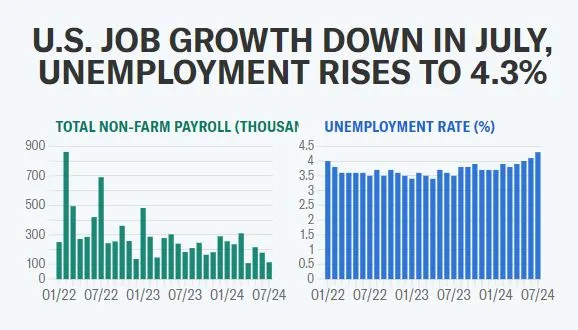The latest US Jobs Report has raised alarm bells across the country, sparking fears of an impending economic downturn. Released by the Bureau of Labor Statistics, the report revealed that the US economy added only 114,000 nonfarm payroll jobs in July. This figure fell significantly short of economists’ expectations, who had predicted an addition of 175,000 jobs. Consequently, the unemployment rate rose to 4.3%, its highest level since October 2021. Such developments have intensified economic recession concerns and triggered the Sahm Rule, which has historically been a reliable predictor of recessions.
The US Jobs Report comes at a time when the Federal Reserve is under immense scrutiny. Many experts argue that the Fed should have already begun lowering interest rates. However, the report’s findings add urgency to the debate. The Fed’s failure to act swiftly could potentially tip the US economy into a recession. This possibility has heightened economic recession concerns among analysts and investors alike.
Analyzing the US Jobs Report: What the Numbers Mean

The US Jobs Report paints a complex picture of the current state of the economy. The US labor market has shown signs of cooling off in recent months. Job growth has slowed considerably, as reflected in the three-month average of 170,000 jobs added. While this number still indicates growth, it is a sharp decline from previous periods of robust job creation.
The rising unemployment rate is a particular point of concern. At 4.3%, it is the highest it has been in nearly three years. More people are finding it difficult to secure employment, and this trend is worrying. The Sahm Rule comes into play here, as it is triggered when the three-month average unemployment rate rises more than 0.5% from its previous 12-month low. Historically, this rule has accurately predicted every recession since the 1970s.
Furthermore, other economic indicators add to the economic recession concerns. For instance, consumer spending, a key driver of economic growth, has shown signs of slowing. Additionally, business investments have been lukewarm, reflecting a lack of confidence in future economic prospects.
Implications for the Federal Reserve
The US Jobs Report puts the Federal Reserve in a challenging position. Policymakers are now under pressure to consider rate cuts sooner rather than later. During a recent meeting, the Fed decided to keep interest rates at a 23-year high. However, this decision is now being questioned in light of the disappointing job numbers.
Fed Chair Jerome Powell has acknowledged the need for vigilance. He stated that the Fed is closely monitoring the US labor market and stands ready to respond to any signs of a sharper downturn. Powell has hinted that a rate cut could be on the table for September, depending on how economic data unfolds.
Many experts believe that the Fed must act decisively to prevent a recession. Some argue that a 25-basis-point cut might not suffice, given the current economic climate. Instead, they suggest that a 50-basis-point cut could send a strong signal to the markets and restore confidence.
The Sahm Rule and Its Relevance
The Sahm Rule has become a focal point in discussions about the US Jobs Report. Named after economist Claudia Sahm, this rule has been a reliable recession indicator for decades. It signals a recession when the three-month average unemployment rate rises more than 0.5% from its previous 12-month low. In this case, the Sahm Rule has been triggered, raising economic recession concerns.
However, Claudia Sahm herself urges caution in interpreting the rule. She notes that while the rule has been accurate in the past, the current economic environment is unique. The aftershocks of the pandemic have introduced new variables that could affect the rule’s reliability.
Despite these caveats, the Sahm Rule serves as a warning signal. Policymakers must take it into account as they navigate the uncertain economic landscape. It underscores the need for proactive measures to address potential risks.
Impacts on the US Labor Market
The US Jobs Report has significant implications for the US labor market. Employers have become more cautious in their hiring decisions. As a result, job growth has slowed, and workers face increased competition for available positions.
Certain sectors have been particularly affected by the slowdown. Manufacturing, retail, and hospitality industries have experienced challenges, contributing to the rise in the unemployment rate. While some industries continue to see growth, others struggle to adapt to changing economic conditions.
The cooling US labor market raises important questions about the future. Workers may need to upskill or reskill to remain competitive. Additionally, policymakers must consider how to support workers in sectors facing headwinds.
Economic Recession Concerns: A Broader Perspective
The US Jobs Report has intensified economic recession concerns across various sectors. Analysts are now revisiting their economic forecasts in light of the new data. While some believe the risk of a recession has increased, others argue that the economy is merely experiencing a temporary slowdown.
Certain economic indicators offer a more optimistic view. For example, the participation rate for prime-age workers remains at a record high. This suggests that more people are entering the workforce, which could bolster economic growth.
Nevertheless, the rising unemployment rate and the Sahm Rule warrant careful consideration. If job growth continues to lag, the risk of a recession will increase. In such a scenario, the Federal Reserve’s response will be crucial in determining the economy’s trajectory.
Conclusion: Navigating the Path Forward
The US Jobs Report has highlighted the complexities of the current economic landscape. The cooling US labor market, rising unemployment rate, and triggering of the Sahm Rule all contribute to a challenging environment. As a result, economic recession concerns have gained prominence in discussions among policymakers, analysts, and businesses.
The Federal Reserve faces a critical decision in the coming months. It must balance the need to support the economy with the risk of market instability. Jerome Powell and his team will need to carefully assess the data and respond accordingly.
For now, the focus remains on navigating this period of uncertainty. Businesses, workers, and policymakers must remain adaptable and vigilant. While challenges lie ahead, opportunities for growth and recovery also exist. The US Jobs Report serves as a reminder of the ever-changing nature of the economy and the importance of proactive decision-making.
In conclusion, the path forward is uncertain, but the stakes are high. The US economy’s resilience and adaptability will be tested in the months to come. By addressing economic recession concerns and responding to the evolving landscape, the nation can work toward a stable and prosperous future.
Click here to read our latest article Impact of Yen Rate on U.S. Stocks

